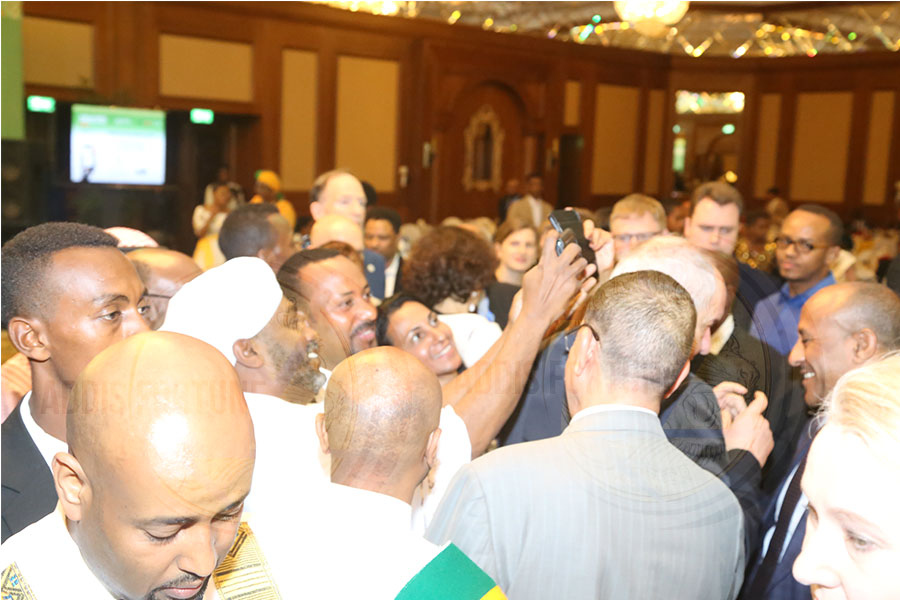
Photo Gallery | 178194 Views | May 06,2019
Sep 28 , 2024.
The Birr has continued spiralling downward against the U.S. Dollar over the past week, deepening the predicaments facing the country's financial system since the authorities liberalised the foreign exchange market in July this year. The currency's rapid depreciation has laid bare underlying economic strains as commercial banks scramble to overcome a volatile environment marked by inconsistent pricing strategies and liquidity concerns.
Between September 23 and 28, exchange rates across 17 commercial banks fluctuated considerably, revealing consequential divergences in buying and selling prices for the Dollar. On September 28, the average buying rate stood at 111.8 Br, while the average selling rate reached 124.9 Br. The depreciation in both rates widened the gap between buying and selling prices, as banks increased their spreads to hedge against growing volatility.
The divergence in exchange rates among the banks unveiled the uncertainty gripping the market following the federal government's decision to open the foreign exchange market. Banks are trying to gasp air with rapidly changing conditions, leading to inconsistent pricing strategies. Outliers like Abay Bank (AYB) and Oromia International Bank (OIB) illustrated the fragmented nature of the market as it adjusts to the floating Birr.
Addis International Bank (AdIB) posted the highest spread over the past week, with the Birr trading at a selling rate of 125.89 Br, a premium of 16pc above its buying price of 108.55 Br. The spread revealed a cautious approach by the bank's executives, likely seeking to buffer against future currency depreciation. Amhara Bank's (AMB) spread stood at eight percent, with the dollar selling at 125.28 Br and buying at 116 Br. The smaller margin reveals a more aggressive strategy to attract foreign exchange, limiting the need to widen its spread drastically.
Oromia International Bank (OIB) consistently posted one of the highest selling rates for the dollar, reaching 127.01 Br on September 28, while its buying price remained relatively subdued at 112.40 Br, yielding a spread of 13pc. Its executives appeared to be reacting to liquidity constraints, possibly facing increased demand for foreign exchange commitments.
Hibret Bank (HB) offered a high spread of 13pc, reflecting a similar cautious positioning as the Birr continues its downward spiral. Abay Bank (AYB) posted the lowest buying rate throughout the week, with the Birr valued at 103.07 on September 28 and a selling rate of 115.43 Br, a spread of 12pc. The unusually low buying rate showed the Bank's desire to limit exposure to foreign currency transactions, perhaps due to liquidity concerns.
While the International Monetary Fund (IMF) praised the authorities' efforts to bridge the gap between official and parallel markets, the short-term volatility has exposed structural weaknesses in the economy, including a growing current account deficit and double-digit inflation. The authorities' decision to float the Birr, a currency historically tightly managed, has led to considerable fluctuations as market forces begin to determine its value. Commercial banks are now forced to overcome these turmoils independently, adjusting their exchange rate offers to reflect internal foreign exchange reserves, external liabilities, and perceived market risks.
As the Birr continues to depreciate, the broader economic consequences of a weaker currency are becoming increasingly evident. Import costs are rising, putting further pressure on inflation, which has remained in double digits for months. Businesses that rely on imported goods face higher costs, often passed on to consumers. Exporters, on the other hand, may find temporary relief with higher returns when converting foreign earnings.
However, the divergence in rates across the banking industry has continued to cause uncertainty as businesses adjust their pricing to avoid risks and remain competitive.
PUBLISHED ON
Sep 28,2024 [ VOL
25 , NO
1274]

Photo Gallery | 178194 Views | May 06,2019

Photo Gallery | 168402 Views | Apr 26,2019

Photo Gallery | 159173 Views | Oct 06,2021

My Opinion | 137055 Views | Aug 14,2021

Oct 25 , 2025
The regulatory machinery is on overdrive. In only two years, no fewer than 35 new pro...

Oct 18 , 2025
The political establishment, notably the ruling party and its top brass, has become p...

Oct 11 , 2025
Ladislas Farago, a roving Associated Press (AP) correspondent, arrived in Ethiopia in...

Oct 4 , 2025
Eyob Tekalegn (PhD) had been in the Governor's chair for only weeks when, on Septembe...